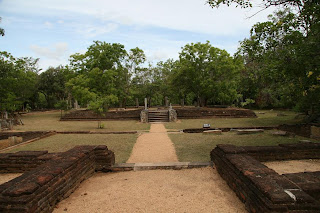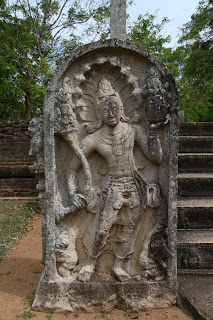Polonnaruwa which served as the capital for three centuries is the next great ancient sites of Sri Lanka after Anuradhpura.




Wednesday, August 29, 2007


Whatever the original purpose may have been, the ruins indicates a sophisticated site with master-planing, architecture, hydraulic engineering, gardening and art.





Half war up the rock you come across the frescos of the buxom,wasp-waisted women. This the most famous of all the Sigiriya features believed to represent aspects of Tara Devi, one of the most important figures in Tantric Buddhism. Although there may have been up to 500 such portraits at one time, only 22 remains today. (images 7 & 8) And said to date back to the 5th century.


The 3m high mirror wall on half way to the top of the rock is a highly polished wall that has been used by visitors for the past 1000 years of their impressions, mainly of the frescos (image 11).


The Lions Paws that is what remains of a sculpture of a giant lion that was the entrance to the final ascent to the top of the rock (image 12)The summit today consist mainly of the remains of foundations (image 13) that had covered most of the 1.6 hectare summit.



 Yapahuwa was the capital of the island from 1277 to 1284 and was a more defendable location from the invading South Indians as it was 100m above the surrounding plains but fell to the invaders in 1284. Altough not a lot survives and some of the finer pieces have been moved to museum in Colombo, the quality of stone carvings are some of the most beautiful we have seen and it is a pleasant view from the top.
Yapahuwa was the capital of the island from 1277 to 1284 and was a more defendable location from the invading South Indians as it was 100m above the surrounding plains but fell to the invaders in 1284. Altough not a lot survives and some of the finer pieces have been moved to museum in Colombo, the quality of stone carvings are some of the most beautiful we have seen and it is a pleasant view from the top.




 Mihintale is just 13km east of Anuradhapura and is of enormous importance to the majority Sinhalese (70%) of the population as this said to be where Buddhism was introduced to the island in 247BC when King Devanampia Tissa met Mahinda, son of Indian Buddhist emperor Ashoka when deer hunting.
Mihintale is just 13km east of Anuradhapura and is of enormous importance to the majority Sinhalese (70%) of the population as this said to be where Buddhism was introduced to the island in 247BC when King Devanampia Tissa met Mahinda, son of Indian Buddhist emperor Ashoka when deer hunting. 



Our first destination Anuradhapura first became a capital in 380BC but it was under the reign of Devanampiya Tissa (247-207BC) that it first rose to great importance and Buddhism said to have arrived in the island in 247BC. For over 1000 years of its reign, Anuradhpura has seen number of South Indian invasions and region in general is dry and hot and even today depends heavily on seasonal monsoon rain for its agriculture. 


Since the arrival of Buddisum in the island, successive rulers in Auradhapura period has devoted vast amount of energy and funds to course.





 Anuradhapura is one of the most important points of local pilgrimage and locals start arriving hear from the very young ages.
Anuradhapura is one of the most important points of local pilgrimage and locals start arriving hear from the very young ages.















